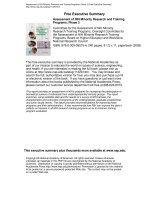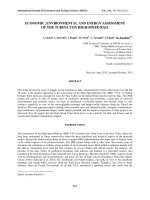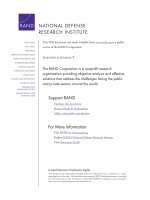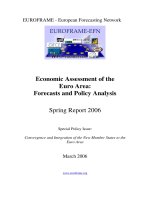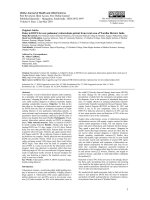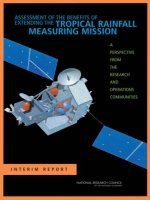Assessment of micronutrient status of Hingoli and Sengaon Tahsils of Hingoli district, India
Bạn đang xem bản rút gọn của tài liệu. Xem và tải ngay bản đầy đủ của tài liệu tại đây (250.54 KB, 12 trang )
Int.J.Curr.Microbiol.App.Sci (2017) 6(4): 1441-1452
International Journal of Current Microbiology and Applied Sciences
ISSN: 2319-7706 Volume 6 Number 4 (2017) pp. 1441-1452
Journal homepage:
Original Research Article
/>
Assessment of Micronutrient Status of Hingoli and Sengaon Tahsils
of Hingoli District, India
S.R. Adat*, T.R. Zagade and H.K. Kausadikar
Department of Soil Science and Agricultural Chemistry, Vasantrao Naik
Marathwada Krishi Vidyapeeth, Parbhani, India
*Corresponding author
ABSTRACT
Keywords
Soil fertility,
Micronutrient,
Fertilisers.
Article Info
Accepted:
12 March 2017
Available Online:
10 April 2017
Although soil fertility mapping can help to apply appropriate fertilisers and effective
fertility management techniques, there is still little information about spatial variability in
fertility status of soil. Therefore this study was conducted at Hingoli and Sengaon tahsils
with objects of assessing fertility status. From the study area 200 soil samples were
collected and analysed in laboratory for micro nutrients. In micro nutrients Zinc indicate
deficient condition followed by Fe, Cu and Mn may be due to frequent cultivation,
variations in management practices, high use of chemical fertilisers. DTPA- Zn content in
soils of Hingoli tahsil were ranged from 0.14 to 1.75 mg kg -1 with a mean value of 0.57 mg
kg-1, DTPA- Fe content were ranged from 1.00 to 18.80 mg kg-1 with an average value of
5.92 mg kg-1, DTPA-Mn content varied from 0.88 to 19.70 mg kg-1 with a mean value of
6.58 mg kg-1. The available DTPA-Cu contents of Hingoli soils were ranged from 0.27 to
5.50 mg kg-1 with an average value of 1.73 mg kg-1. The data revealed from Sengaon tahsil
that the available Zn content of these soils was ranged from 0.15 to 1.28 mg kg-1 with a
mean value of 0.49 mg kg-1. The available Fe content of these soils was varied from 0.96
to 12.85 mg kg-1 with an average value of 5.90 mg kg-1. The available Cu content in the
soils of Sengaon tahsil were ranged from 0.12 to 3.86 mg kg -1 with a mean value of 1.17
mg kg-1. The lowest range 1.70 to 5.75 mg kg-1 Mn with a mean value of 4.06 mg kg-1
were observed in Makodi whereas highest range 6.87 to 14.00 mg kg -1 with an average
value of 9.72 mg kg-1 Mn was recorded in village Wadhivra village. Therefore for
increasing fertility of soil create public awareness about environmentally and socially
acceptable integrated nutrient management practices like use of organic inputs, balanced
use of chemical fertilisers, agro-forestry system and improved crop varieties can be
adopted. Thus, it can be concluded that soils of Hingoli and Sengaon tahsil are low to
medium in fertility status.
Introduction
Out of 329 million ha. area of the country, net
cropped area 142 million ha. and about 175
million ha. suffers from different limitations.
There is no additional land source available
for horizontal expansion of soil to increase the
net cultivated area, as the land to man ratio
narrowing rapidly, the future requirement has
to be met through intensification of
agriculture (Sawashe, 2008).
Hingoli, a part of Parbhani district came into
being as a district on may 1st 1999. Located in
1441
Int.J.Curr.Microbiol.App.Sci (2017) 6(4): 1441-1452
central Maharashtra but more nearer to
Eastern district of Maharashtra with latitude
and longitude of 19.43 0N and 77.11 oE
Hingoli district covered about 473400 ha
geographical area with five tahsils Hingoli,
Kalamnuri, Sengaon, Vasmath and Aundha
Nagnath.
spectroscopy by atomic absorption spectro
meter model AA200 Perkin Elmer.
These Tahsils comes under Agro ecological
unit No.6 except Kalamnuri which comes
under Agro ecological unit No.8. About
421300 ha land is available for cultivation out
of these total cultivable land, Kharif season
shares 311200 and Rabi season 116400 ha.
The data presented on DTPA-Zn and their
categorization in revealed that, DTPA- Zn
content in soils of Hingoli tahsil were ranged
from 0.14 to 1.75 mg kg-1 with a mean value
of 0.57 mg kg-1. The lowest Zn content was
recorded in Ghota (sample no. HE2) while
highest Zn content was observed in soils of
Boralwadi village (sample no. HB3). The
lowest range 0.14 to 0.89 mg kg-1 in Zn
content with an average value of 0.34 mg kg-1
was recorded in Ghota where as highest range
0.22 to 1.75mg kg-1 with a mean value of 0.82
were observed in Boralwadi village. Among
twenty villages, 11 villages were low, while
remaining, 9 were medium in Zn content. Out
of 100 samples, 69 per cent in low (< 0.60 mg
kg-1), 21 per cent in medium (0.60 to 1.20 mg
kg-1) and 10 per cent samples were
categorized under high (1.2 mg kg-1) Zn
content.
The total geographical area of Hingoli is
4,73,400 ha. and soils of this region varied in
different physical and physico-chemical
properties. Hingoli district comprises five
tahsils and out of these two are selected for
present study. Soil as well as crop differs
significantly in their behavior due to their
differential characteristics.
To know the present status of soil and future
productivity, it is essential to know the
fertility status. Considerable work on physicchemical properties of Maharastra soils was
reported (Bharambe, 2001). Thus, it is
necessary to define the areas of deficiency of
particular nutrients in a particular areas and
crops. Soil test data would be helpful in
growing such deficient areas on soil and crop
basis. Thus, the details of soil resource
thematic maps and using data on various soil
properties, focus given on fertility status,
hence, present investigation is useful in
judging the deficiencies of various nutrients.
Materials and Methods
Available Cu, Fe, Mn and Zn (DTPA
extractable) were determined by using
extraction method as described by Lindsay
and Norvell (1978) using diethylene triamine
penta acetic acid (DTPA), triethanolamine
(TEA) extractant with the help of absorption
Results and Discussion
Status of DTPA- Zn, Fe, Mn and Cu of
Hingoli tahsil soils
The values indicated that Zn content in
Hingoli soils were low to medium. Majority
of these soils were marginal in available Zn
content. This might be due to DTPA
extractable Zn decreases with depth because
of low organic matter and variable in clay
content. Also under alkaline condition the
Zinc cations are charged largely to their
oxides or hydroxides and thereby lower the
availability of Zinc. Pharande et al., (1996)
reported that Zinc status of Western
Maharashtra ranged from 0.21 to 3.94 mg kg-1.
The similar results were reported by Shinde,
(2007).
Further, data presented in table indicated that
the DTPA- Fe content of these soils were
ranged from 1.00 to 18.80 mg kg-1 with an
1442
Int.J.Curr.Microbiol.App.Sci (2017) 6(4): 1441-1452
average value of 5.92 mg kg-1. The lowest Fe
was recorded in (66sample no.HN1) and
highest recorded in (sample no.HS4). The
lowest range 1.34 to 3.88 mg kg-1 with a mean
value of 2.49 mg kg-1 was recorded in village
Ghota while highest range 3.62 to 18.80 mg
kg-1 in Zn content with an average value of
12.01 mg kg-1 was observed in soils of
Pimpaldari village. Among twenty villages, 1
villages viz. Ghota (2.49 mg kg-1) was low in
Fe contain, 8 villages were medium whereas
11 villages were high in Fe content (Tables 1
and 2).
Out of 100 samples, 17 per cent samples were
low (<2.5 mg kg-1), 26 per cent were medium
(2.5 to 4.5 mg kg-1) and 47 per cent samples
were high (> 4.5 mg kg-1) in DTPA-Fe
content. These values showed that soils of
Hingoli tahsils were low to high in available
DTPA-Fe content. This high Fe content in
soil may be due to presence of minerals like
Feldspar, Magnetite, Haematite and Limonite
which constitute bulk of trap rock in these
soils. Malewar and Ismail (1999) reported that
the available Fe content of Marathwada soils
were ranges from 0.36 to 25.15 mg kg-1.
These results were similar with the results
reported by Pharande et al., (1996) and
Jibhakate et al., (2009).
The available DTPA-Mn content of these
soils was varied from 0.88 to 19.70 mg kg-1
with a mean value of 6.58 mg kg-1. The lowest
value of Mn was recorded in village Pangari
(sample no. HP4), while highest Mn content
was observed in Digraj village (sample
no.HK1). The lowest range 1.12 to 6.56 mg
kg-1 in Mn content with an average value of
3.51 mg kg-1 were observed in Pimpaldari
whereas, highest range 6.95 to 15.16 mg kg-1
with a mean value of 10.51 mg kg-1 was
recorded in Boralwadi village. Among twenty
villages, 4 villages namely Hingoli (4.21 mg
kg-1), Bhandegaon (4.22 mg kg-1), Karanjali
(3.97 mg kg-1) and Pimpaldari (3.51 mg kg-1)
were medium in Mn content whereas,
remaining 16 villages were high in Mn
content. Out of 100 sample, 16 per cent in low
(< 2 mg kg-1), 24 per cent in medium (2 to 5
mg kg-1) and 60 per cent high (> 5 mg kg-1) in
Mn content. (Fig.7.3).
These value showed that soils of this tahsil
were low to high in Mn content. The high
status of Mn in these soils might due to the
fact that lower Oxidation (Reduced) status of
Mn are more soluble than higher oxidation
state at Norman pH range of soil, Oxidation
of divalent Mn++ to trivalent Mn+++ by certain
Fungi and bacteria, also some organic
compounds synthesized by micro-organisms
or released by plans as root exudates have
oxidizing or reducing power..The similar
results were reported by Pharande et al.,
(1996) and Aage et al., (2007).
The available DTPA-Cu contents of Hingoli
soils were ranged from 0.27 to 5.50 mg kg-1
with an average value of 1.73 mg kg-1. The
lowest value (0.27 mg kg-1) of Cu content was
recorded in village Pimpaldari, (sample
no.HS2) where as highest value of Cu was
recorded in soils of Takli village. (sample
no.HT4). The lowest range 0.65 to 0.94 mg
kg-1 with mean value of 0.82 mg kg-1 were
recorded in Takli village while highest range
0.56 to 5.50 mg kg-1 with an average value of
2.63 mg kg-1 were observed in Takli village in
available Cu content in these soils of Hingoli
tahsil. The soils of all selective villages were
high in available Cu contents. Out of 100
samples, 3 per cent were low, 3 per cent were
medium and 94 per cent high content of Cu.
The high content of Cu in these soils were
might be due to presence of Cu minerals like
Cuprite and chalcocite, etc. in the parent
material. Pharande et al., (1996) reported that
the available status of Cu content of soil
varied from 0.40 to 6.70 mg kg-1. Similar
results were reported by Dhane et al., (1995),
Dhage et al., (2000) and Malewar (1994).
1443
Int.J.Curr.Microbiol.App.Sci (2017) 6(4): 1441-1452
Table.1 Micronutrient status of Hingoli tahsil soils
Sr.
No.
Sample
No.
Zn
(mg kg-1)
Mn
(mg kg-1)
Fe
(mg kg-1)
Cu
(mg kg-1)
1
HA1
0.43
3.40
2.82
2.60
2
HA2
0.60
8.62
4.00
2.90
3
HA3
0.32
5.78
7.62
1.80
4
HA4
1.45
12.60
3.16
3.88
5
HA5
0.30
2.02
4.40
1.15
6
HB1
0.69
15.16
8.86
2.75
7
HB2
0.22
10.74
4.58
4.20
8
HB3
1.75
6.95
2.16
0.65
9
HB4
0.58
10.31
4.00
1.30
10
HB5
0.88
9.40
3.45
0.86
11
HC1
0.55
2.16
4.56
1.70
12
HC2
0.44
8.40
3.28
0.42
13
HC3
0.63
2.45
2.24
1.10
14
HC4
0.48
5.50
3.65
1.14
15
HC5
0.38
11.12
1.95
0.72
16
HD1
0.48
1.85
4.13
1.92
17
HD2
0.32
7.34
3.14
1.38
18
HD3
0.46
0.98
2.89
1.03
19
HD4
0.20
10.45
3.35
1.50
20
HD5
0.64
5.54
1.97
0.82
21
HE1
0.18
4.50
2.86
2.00
22
HE2
0.14
8.82
2.58
3.50
23
HE3
0.28
17.15
1.34
2.14
24
HE4
0.89
2.80
3.88
1.88
25
HE5
0.24
6.89
1.80
1.78
1444
Int.J.Curr.Microbiol.App.Sci (2017) 6(4): 1441-1452
Sr.
No.
Sample
No.
Zn
(mg kg-1)
Mn
(mg kg-1)
Fe
(mg kg-1)
Cu
(mg kg-1)
26
HF1
0.54
1.78
2.63
2.16
27
HF2
0.36
9.72
1.46
0.82
28
HF3
1.22
3.78
2.44
0.92
29
HF4
0.55
12.40
4.95
0.84
30
HF5
0.35
4.90
6.20
0.98
31
HG1
1.04
1.72
1.88
4.42
32
HG2
0.20
2.42
5.78
2.14
33
HG3
0.30
9.22
5.26
3.50
34
HG4
0.36
10.48
5.00
2.58
35
HG5
0.24
9.18
7.20
0.91
36
HH1
0.42
4.20
7.10
0.85
37
HH2
0.32
1.23
6.34
0.75
38
HH3
0.45
7.84
8.32
0.94
39
HH4
0.58
6.22
5.34
0.65
40
HH5
0.94
1.58
5.92
0.91
41
HI1
1.20
5.28
4.22
1.05
42
HI2
0.34
2.02
5.46
2.46
43
HI3
1.28
14.16
5.17
1.34
44
HI4
0.42
4.20
1.80
0.32
45
HI5
0.58
9.06
4.42
0.88
46
HJ1
0.43
0.98
6.34
0.72
47
HJ2
0.81
2.26
5.42
1.80
48
HJ3
0.44
11.3
7.21
2.44
49
HJ4
0.68
6.96
2.47
1.32
50
HJ5
1.44
3.64
3.15
1.72
1445
Int.J.Curr.Microbiol.App.Sci (2017) 6(4): 1441-1452
Sr.
No.
Sample
No.
Zn
(mg kg-1)
Mn
(mg kg-1)
Fe
(mg kg-1)
Cu
(mg kg-1)
51
HK1
0.84
19.70
6.09
2.40
52
HK2
0.28
5.50
11.16
0.91
53
HK3
0.89
1.68
9.48
0.38
54
HK4
0.82
6.50
5.18
0.71
55
HK5
0.54
8.44
10.04
2.92
56
HL1
0.62
1.90
11.40
1.49
57
HL2
0.50
3.15
8.10
3.78
58
HL3
0.57
14.20
2.30
4.90
59
HL4
0.44
11.62
12.48
0.28
60
HL5
0.51
6.41
12.85
0.82
61
HM1
0.67
3.45
12.48
2.42
62
HM2
0.84
8.42
9.78
2.82
63
HM3
0.45
2.47
10.65
0.94
64
HM4
0.18
11.10
6.08
3.50
65
HM5
0.42
1.42
3.64
1.88
66
HN1
0.18
7.32
1.00
4.42
67
HN2
0.72
9.48
6.40
0.70
68
HN3
1.40
5.64
9.80
1.08
69
HN4
0.34
1.32
14.22
0.68
70
HN5
0.46
10.88
11.48
0.34
71
HO1
0.43
10.80
4.20
1.72
72
HO2
0.49
4.94
8.82
0.84
73
HO3
0.54
2.04
4.58
1.31
74
HO4
1.27
1.22
2.16
2.70
75
HO5
0.78
2.10
2.24
1.22
1446
Int.J.Curr.Microbiol.App.Sci (2017) 6(4): 1441-1452
Sr.
No.
Sample
No.
Zn
(mg kg-1)
Mn
(mg kg-1)
Fe
(mg kg-1)
Cu
(mg kg-1)
76
HP1
0.40
5.78
3.14
0.68
77
HP2
0.68
4.30
1.86
0.92
78
HP3
0.54
8.42
2.65
0.74
79
HP4
0.32
0.88
6.78
1.19
80
HP5
0.44
11.62
7.20
2.32
81
HQ1
1.22
10.40
10.32
2.42
82
HQ2
0.72
6.22
5.18
3.52
83
HQ3
0.58
19.20
11.5
3.62
84
HQ4
0.30
6.49
5.18
0.85
85
HQ5
0.26
7.32
12.86
2.12
86
HR1
0.18
11.38
8.10
2.32
87
HR2
0.31
2.70
9.42
2.00
88
HR3
0.72
5.20
7.78
1.66
89
HR4
0.41
1.84
12.04
2.14
90
HR5
0.82
8.76
4.82
1.50
91
HS1
0.44
1.97
3.62
0.72
92
HS2
0.34
4.10
18.36
0.27
93
HS3
0.25
6.56
9.66
0.81
94
HS4
0.38
3.84
18.8
1.12
95
HS5
0.48
1.12
9.65
1.56
96
HT1
0.54
10.10
1.00
3.10
97
HT2
0.57
8.82
3.45
2.80
98
HT3
1.29
5.52
4.94
0.56
99
HT4
0.35
15.48
3.20
5.50
100
HT5
0.38
1.69
3.68
1.20
Mean
0.57
6.58
5.92
1.73
1447
Int.J.Curr.Microbiol.App.Sci (2017) 6(4): 1441-1452
Table.2 Micronutrients status of Sengaon tahsil
Sr.No.
1
2
3
4
5
6
7
8
9
10
11
12
13
14
15
16
17
18
19
20
21
22
23
24
25
26
27
28
29
30
31
32
33
34
35
36
37
38
39
40
41
Sample
No.
SA1
SA2
SA3
SA4
SA5
SB1
SB2
SB3
SB4
SB5
SC1
SC2
SC3
SC4
SC5
SD1
SD2
SD3
SD4
SD5
SE1
SE2
SE3
SE4
SE5
SF1
SF2
SF3
SF4
SF5
SG1
SG2
SG3
SG4
SG5
SH1
SH2
SH3
SH4
SH5
SI1
Fe
(mg kg-1)
3.45
1.42
3.12
6.2
4.96
1.08
5.3
4.38
5.31
8.97
5.42
8.98
7.21
2.54
6.34
5.44
4.42
8.48
7.52
8.9
5.1
4.42
3.36
2.05
5.18
10.32
11.22
8.48
1.46
6.5
7.22
1.8
4.8
2.98
6.2
7.35
3.88
1.94
6.34
7.81
4.26
Mn
(mg kg-1)
11.38
8.72
2
10.44
14.92
2.34
6.56
6.85
3.12
1.7
10.43
8.45
2.78
8.76
5.5
1.05
6.3
2.22
5.78
9.6
6.65
1.7
7.78
3.2
10.4
8.45
2.84
6.68
9.72
6.6
10.28
8.42
4.2
8.72
6.9
5
3.12
7.32
11.3
1.26
5.56
1448
Zn
(mg kg-1)
0.81
0.36
0.42
0.23
0.38
1.22
0.19
0.88
0.38
0.48
1.28
0.42
0.54
0.52
0.25
1.21
0.91
0.33
0.21
0.54
0.77
0.55
0.21
1.28
0.15
0.28
0.18
0.72
0.45
0.38
0.27
0.43
0.32
0.54
1.26
0.5
0.62
0.79
0.4
0.42
0.3
Cu
(mg kg-1)
2.32
0.68
2
2.16
0.83
1.18
0.32
0.28
0.64
1.32
2.78
2.34
2
3.18
0.62
0.74
0.98
1.05
1.77
0.98
0.12
0.94
0.58
0.75
0.98
1.3
1.72
1.24
1.14
2.32
2.6
0.96
0.26
2.2
0.5
1.7
0.95
0.38
1.22
1.5
2.68
Int.J.Curr.Microbiol.App.Sci (2017) 6(4): 1441-1452
42
43
44
45
46
47
48
49
50
51
52
53
54
55
56
57
58
59
60
61
62
63
64
65
66
67
68
69
70
71
72
73
74
75
76
77
78
79
80
81
82
83
84
85
86
SI2
SI3
SI4
SI5
SJ1
SJ2
SJ3
SJ4
SJ5
SK1
SK2
SK3
SK4
SK5
SL1
SL2
SL3
SL4
SL5
SM1
SM2
SM3
SM4
SM5
SN1
SN2
SN3
SN4
SN5
SO1
SO2
SO3
SO4
SO5
SP1
SP2
SP3
SP4
SP5
SQ1
SQ2
SQ3
SQ4
SQ5
SR1
8.92
0.98
4.55
7.25
8.44
3.22
5.48
7.5
12.5
3.45
6.9
1.52
9.88
10.34
2.92
7.08
2.35
5.44
3.22
3.12
4.5
8.36
9.48
1.2
6.35
10.04
9.6
5.18
11.4
2.28
12.85
7.1
5.42
9.12
8.1
0.96
2.68
6.48
9.35
7.45
8.87
2.15
12.5
4.72
3.75
12.28
7.1
6.05
4.78
3.04
5.75
1.7
5.5
4.34
2.02
11.3
6.22
7.78
0.98
7.55
5.91
12.24
12.74
9.34
11.37
2.7
2
5.2
8.72
14.32
6.56
2.76
12.32
15.14
6.87
8.34
14
8.8
10.7
9.82
2.75
9.7
1.3
6.45
12.2
11.18
9.1
6.71
5.98
6.45
1449
0.38
0.26
0.18
0.22
0.3
0.54
0.44
0.28
1.2
0.62
1
0.41
0.58
0.56
0.2
0.32
0.36
0.2
0.43
0.28
0.42
0.68
0.32
0.22
1.23
0.26
0.81
0.36
0.18
0.15
0.35
0.38
0.4
0.25
0.51
0.63
0.17
0.55
1.28
0.33
0.19
0.41
0.34
1.22
0.37
0.98
1.04
2.14
0.78
1.25
1.74
0.42
1.56
0.75
1.72
0.21
0.86
1.42
0.96
2.9
0.48
0.72
1.02
0.62
0.97
1.92
2.84
0.71
0.22
0.99
1.21
1.08
0.6
0.68
0.88
1.5
0.48
0.72
0.78
0.72
2.12
0.79
1.12
0.3
1.26
1.3
1.9
0.62
0.78
0.32
Int.J.Curr.Microbiol.App.Sci (2017) 6(4): 1441-1452
87
88
89
90
91
92
93
94
95
96
97
98
99
100
SR2
SR3
SR4
SR5
SS1
SS2
SS3
SS4
SS5
ST1
ST2
ST3
ST4
ST5
Mean
12.6
5.3
4.28
8.68
8.3
1
5.92
2.44
3.89
10.65
5.13
4.42
7.22
8.32
5.95
8.36
10.6
6.9
8.72
7.35
5.2
2.31
8.4
10.1
12.45
11.6
6.95
9.85
7.7
7.19
Status of available Zn, Fe, Mn and Cu of
Sengaon tahsil of soils
The data revealed that the available Zn content
of these soils were ranged from 0.15 to 1.28 mg
kg-1 with a mean value of 0.49 mg kg-1. The
lowest Zn content was observed in village
Wadhivra (sample no. SO1) while highest Zn
content was recorded in Bhankheda, Goregaon
and Sengi village (sample no.SC2, SE4 and
SP5). The lowest range 0.18 to 0.38 mg kg-1
with a mean value of 0.26 mg kg-1 were
observed in village Kendre where as highest
range 0.21to 1.21 mg kg-1 with an average value
of 0.64 mg kg-1 were recorded in Chaundi
village. Out of Twenty villages, 17 villages
were low in Zn content whereas, remaining
villages viz., Ajegaon (0.63 mg kg-1),Mhalsi
(0.0.63 mg kg-1) and Sengi (0.62) villages were
moderate in Zn content. Among 100 soil
samples, 76 per cent low, 14 per cent moderate
and 10 per cent were categorized in high Zn
content.
The above values indicated that the soils of
Sengaon tahsil were low to high in Zn content.
The most of the soils were low in Zn content. In
well drained aerated calcareous soils Zinc exist
in oxidized state and its availability become
low. The similar results were also reported by
Pharande et al., (1996) and Waghmare (2007).
0.24
0.32
0.25
0.2
0.47
1.21
0.19
0.38
0.49
0.71
1.25
0.45
0.23
0.35
0.49
1.12
2.2
0.98
0.65
2
0.95
0.2
1.36
0.71
2.05
0.37
0.91
0.67
0.75
1.17
The available Fe content of these soils were
varied from 0.96 to 12.85 mg kg-1 with an
average value of 5.90 mg kg-1.The low Fe
content was recorded in village Sengi (sample
no. SP2) while high Fe content was observed in
village Wadhivra (sample no. SO2). The lowest
range 1.42 to 6.20 mg kg-1 with a mean value of
3.83 mg kg-1 in Fe content were recorded in
Adul village while highest range 1.46 to 11.22
mg kg-1 with an average value of 7.59 mg kg-1
Fe content were observed in village Gondala.
Villages of Sengaon tahsil were high in Fe
content. Out of 20 villages, 4 villages were
medium and 16 villages were high in Fe
content. Out of 100 samples, 13 per cent
samples in low, 20 per cent were medium and
67 per cent were categorized in high Fe content.
Maximum soils of these tahsil were rich in Fe
content. This could be attributed to silicate clays
contains Fe in octahedral layer especially in 2: 1
type of clay minerals (Smectite). Fe released
from the clay under certain soil conditions on
their concentrations in soil solution is increased
by fertilizer application of Fe content. Malewar
and Ismail (1999) reported that the soils of
Marathwada region were ranges from 0.36 to
25.14 mg kg-1. These results were in
confirmatory with result reported by Meena et
al., (2006) and Shinde (2007).
1450
Int.J.Curr.Microbiol.App.Sci (2017) 6(4): 1441-1452
Further data revealed that the available Mn
content in these soils was varied from 0.98 to
15.14 mg kg-1 with a mean value of 7.19 mg kg1
. The lowest Mn content (0.98 mg kg-1) was
recorded in soils of Mhalshi village (sample
no.SK5) while highest Mn content (15.14 mg
kg-1) was found in soils of Sapatgaon
village.(sample no.SN5).The lowest range 1.70
to 5.75 mg kg-1 Mn with a mean value of 4.06
mg kg-1 were observed in Makodi whereas
highest range 6.87 to 14.00 mg kg-1 with an
average value of 9.72 mg kg-1 Mn was recorded
in village Wadhivra. Out 20 villages, 3 villages
Viz. Ajegaon (4.11 mg kg-1), Chundi (4.99 mg
kg-1) and Makodi (4.06 mg kg-1) were
categorized medium and remaining 17 villages
were categorized in high content of Mn. Among
the 100 soil samples, 15 percent in moderate
and 85 percent samples were high in Mn
content.
The relative high content of Mn in these soils
could be due to the soils derived from basaltic
parent material which contained higher
ferromagnessiume minerals. Hundal et al.,
(2006) reported that the available Mn content
were ranged from 0.07 to 18.56 mg kg-1. Similar
findings were reported by Malewar and Ismail
(1999).
The available Cu content in the soils of Sengaon
tahsil were ranged from 0.12 to 3.86 mg kg-1
with a mean value of 1.17 mg kg-1. The lowest
Cu content was observed in soils of Goregaon
village (sample no.SE1) whereas, highest Cu
content was found in soils of Mhalshi village.
(sample no. SK3). The lowest range 0.12 to
0.98 mg kg-1 with an average value of 0.67 mg
kg-1 in Cu content was observed in village
Goregaon whereas, highest range 0.62 to 3.18
mg kg-1 with a mean value of 2.18 mg kg-1 was
recorded in Bhankheda village. The villages of
Sengaon tahsil (100 samples) were categorized
as, 7 per cent under low, 8 per cent under
medium and 85 per cent high Cu content.The
high content of Cu in these soils could be
attributed to the difference in geology,
physiology and degree of weathering in these
soils. Malewar (1994) reported that the Cu
content in Marathwada soil were varied from
1.2 to 7.40 mg kg-1. Similar results also reported
by Dhage et al., (2000) and Gupta et al., (2003).
References
Aage, A.B., Magar, S.M., Godhawale, G.V. and
Borgaonkar, S.B. 2007a. Studies on
Available micronutrient status in Beed
district of Maharashtra state. Int. J. Trop.
Agri., 25(3): 491-494.
Basavaraju, N.G., Mir Khamir Ali and Ravi,
M.V. 2008. Distribution of zinc and their
relationship with physico- chemical
properties in Black soils of Sira Taluka
Tumkur district, Karnataka. Maysore J.
Agric. Sci., 42(3): 450-455.
Bharmbe, P.R. and Ghonshikar, C.P. 1984.
Fertility status of soils in Jayakwadi
command. J. Maharastra Agric. Univ.,
9(3): 326-327.
Binita, N.K., Dasog, G.S. and Patil, P.L. 2009.
Soil fertility mapping in Ghatprabha left
bank canal command area of north
Karnataka by geographic information
system technique. Karnataka J. Agric.
Sci., 22(1): 81-88.
Black, C.A. 1965. Methods of soil Analysis
part-2. American society of Agron. In. C.
Madison Wiscousin, USA.
Chopra, S.L. and Kanwar, J.B. 1976. Analytical
Agricultural Chemistry. Kalyani publ.,
New Delhi.
Dhage, A.R., Mane, S.R. and Adsule, R.N.
2000. Available micronutrient in soils of
Shevgaon tahsil (Ahmadnagar) in relation
to soil characteristics. J. Maharashtra
Agric. Univ., 35(1): 97-98.
Dhane, S.S. and Shukla, L.M. 1995.
Distribution of DTPA extractable Zn, Cu,
Mn and Fe in some soil series of
Maharashtra and their relationship with
some soil properties. J. Indian Soc. Soil.,
43(4): 597-600.
Dhanya, V., Mathews., Patil, P.L. and Dasog,
G.S. 2009. Identification of soil fertility
constraints of a pilot site in coastal agro
ecosystem of Karnataka by GIS
1451
Int.J.Curr.Microbiol.App.Sci (2017) 6(4): 1441-1452
techniques. Karnataka J. Agric. Sci.,
22(1): 77-80.
Dolui, A.K. and R. Bera. 2001. Soil tests for
available Iron and their Relation with soil
properties in some Alfisols of Orissa
India. Int. J. Trop. Agri., 19(1-4): 5-15.
Dwivedi, S.K., Sharma, V.K. and Bhardwaj,
Vipin. 2005. Status of available nutrients
in soils of cold arid region of Ladakh. J.
Indian Soc. Soil Sci., 53(3): 421-423.
Gupta Naresh, S.K., Trivedi, K.N., Bansal and
Kaul, R.K. 2003. Vertical distribution of
micronutrient cations in some soil series
of Northern Madhya Pradesh. J. Indian
Soc. Soil. Sci., 51(4): 517-522.
Hegde, D.M. and Sudhakara Bapu, S.N. 2001.
Nutrient management strategies in
Agriculture, A future outlook. Fertilizer
News, 46(12): 61-66.
Jibhkate, S.B., Raut, M.M., Bhende, S.N. and
Kharche, V.K. 2009. Micronutrient status
of soils of Katol tahsil in Nagpur district
and their Relationship with some soil
properties. J. Soils and Crops, 19(1): 143146.
Krishna Murthy and Srinivas Murthy. 2005.
Distribution
of
some
available
micronutrients in black and red soils of
Karnataka. Mysore J. Agric. Sci., 39(1):
57-63.
Lindsay, W.L. and Norvell, W.A. 1978.
Development of DTPA soil test for Zn,
Fe, Mn and Cu. Soil Sci. Soc. Amer. J.,
42: 421-425.
Mahapatra, P.K. and Sahu, S.K. 1996.
Relationship between some major,
secondary and micronutrient status of
soils growing groundnut and their
contents in groundnut plants. J. Indian
Soc. Soil. Sci., 44(1): 100-103.
Malewar, G.U., Dhamak, A.L. and Ismail, S.
1998. Inter relationship of forms of Fe
with properties of soils of semi arid area
of Northen Marathwada J. Maharashtra
Agric. Univ., 23(2): 201-202.
Malewar, G.U. and Syed Ismail. 1999.
Increasing significance of micronutrients
in sugarcane production special paper
presented at XVth cane development
workshop on soil fertility Management
Vasantdada Sugar Institute, Manjari
(Pune) Sept. 17-18, 1999 PP : 24-32.
Malewar, G.U. and Ghonshikar, C.P. 1984.
Maharashtra soils and their Zinc
chemistry. J. Maharashtra Agric. Univ.,
9(1): 1-7.
Mali, C.V. and Syed Ismail. 2002.
Characterization and fertility status of
Marathwada
soils
sulphur
and
micronutrient in soil resource inventory
of
Marathwada
Departments
of
Agricultural chemistry and soil science.
MAU Parbhani,72-57.
Mali, C.V., Gorde, A.S., Rekhawar, B.V. and
Malewar, G.U. 1994. Micronutient status
of some sweet orange growing soils in
Aurangabad district. Paper published in
seminar on recent trends in Micronutrient
Research in soils and plants in
Maharashtra, organized by PCISSS, at
Marathwada Agril. Univ. Nov. 12 & 13,
1994 Abst., PP. 18.
How to cite this article:
Adat, S.R., T.R. Zagade and Kausadikar, H.K. 2017. Assessment of Micronutrient Status of Hingoli
and Sengaon Tahsils of Hingoli District. Int.J.Curr.Microbiol.App.Sci. 6(4): 1441-1452.
doi: />
1452

